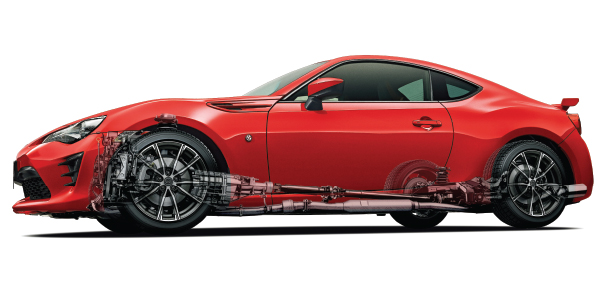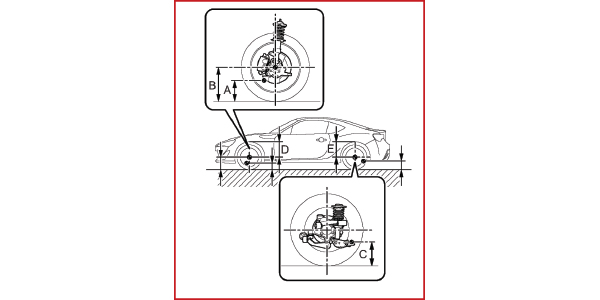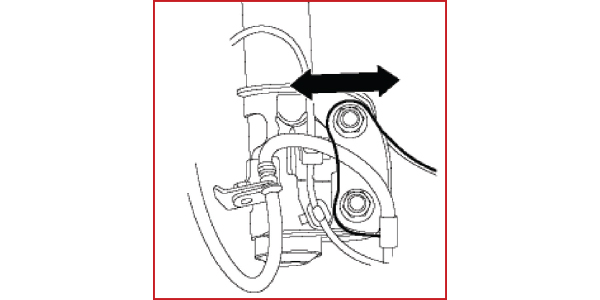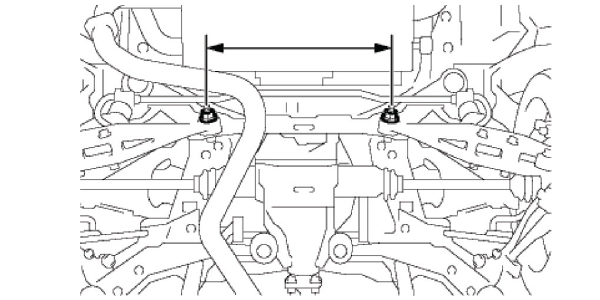
The Scion FR-S and Subaru BR-Z are essentially the same vehicle except for some badging and styling touches. The rear-wheel-drive platform has a Subaru engine and rear suspension. The BR-Z is the only Subaru in the lineup without all wheel drive, and the only Scion that sends power to the rear, respectively.
The FR-S and BR-Z use a narrow 215/45R17 tire. It is the same Michelin Primacy HP summer tire used on the top trim level of the Prius. This tire is designed with a smaller contact patch for lower rolling resistance, and, therefore lower traction. The platform also has tuned springs and sway bars that are set up to aid in weight transfer. This makes for a vehicle that is drift capable right off the showroom floor.
The alignment of these vehicles is straightforward, and a lot of adjustment is built into the vehicle. If the vehicle is lowered with coilovers or lowering springs, the change in geometry might require additional parts.
Ride Height
The ride height is taken using four different measurements. The main measurement is taken from the center of the wheel to the top of the wheel arch. The stock measurement should be around 372-375mm using the stock wheels and tires.
The other measurements are more of a diagnostic procedure that involves measuring points on the inboard mounting and their relationship with the ground. Please consult the service information for this procedure. These measurements can help to diagnose bent or damaged components.

Front Suspension
The front suspension uses a MacPherson strut. Unlike a lot of modern suspensions, the FR-S uses stamped steel lower control arms.
Camber is adjusted by loosening the upper bolt that holds the strut to the knuckle and keeps it from moving in or out. The stock bolts offer a limited range of adjustment. Aftermarket cam bolts that fit upper and lower holes can give ±1.75 degrees of adjustment. If more adjustment is needed, aftermarket upper strut mounts can be installed that can also make the caster adjustable.
The large bushing on the lower control arm is designed to produce small changes in the toe and camber when the car brakes or accelerates. It has to be correctly orientated in the control arm to do its job.

Rear Suspension
The rear suspension on these vehicles is from the Subaru Impreza. The multilink arrangement has built-in toe and camber adjustments. Rear toe is adjustable with a toe link. The eccentric adjuster is on the subframe. The lower control arm controls the camber with an eccentric on the inner mount on the subframe.
If more camber or toe is required to compensate for a lowered vehicle, aftermarket parts are available that yield the capability for significant adjustment.
Steering Angle Sensor Calibration
In the case of the steering angle sensor, the Subaru and Toyota versions have the same ABS and stability control systems from Toyota. Like most Toyotas, the calibration procedure for the steering angle sensor for the FR-S and BR-Z is called a “zero-point calibration.” It requires the use of a tool that can interface with the ABS/VSC module. The procedure also resets the yaw and lateral accelerometer sensors.
While performing the procedure, keep the vehicle stationary and do not vibrate, tilt, move or shake. Perform the procedure on a level surface (with an inclination of less than 1 degree).
Verify the calibration by looking at the steering angle sensor data. In some cases, the correct values will not be displayed until a full lock-to-lock steering wheel movement is made and a short test drive is carried out.

Toyota Eliminates The Scion Brand
The Scion FR-S for 2017 was badged as the F-86 because of the phasing out of the Scion brand. All Scion models have since been absorbed into the Toyota line.
Article courtesy ImportCar.













